Introduction
On May 20, 2015, the Office of the Director of National Intelligence declassified numerous documents found at Osama bin Laden's compound in Abbottabad, Pakistan, and published them on a specially designated website.[1] The release garnered widespread media attention. Most of the media highlights centered on the many books found on bin Laden's bookshelf, on the fact that many of them were about U.S. Middle East policy, 9/11 conspiracy theories, and anti-Semitic conspiracy theories, and that a number were by leftist thinkers.
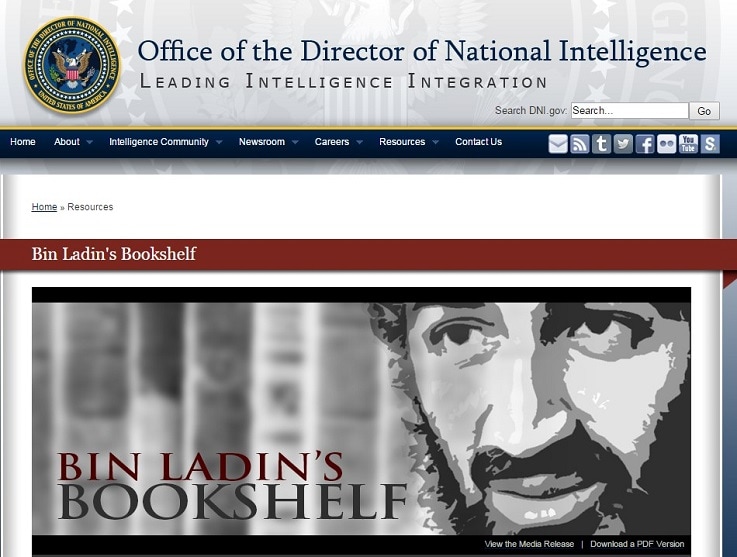
More specifically, some of the more notable books included: Confessions of an Economic Hit Man by John Perkins; Imperial Hubris by Michael Scheuer; Killing Hope: U.S. Military and CIA Interventions Since World War II and Rogue State: A Guide to the World's Only Superpower by William Blum; and Hegemony or Survival: America's Quest for Global Dominance and Necessary Illusions: Thought Control in Democratic Societies by Noam Chomsky, as well as mainstream books including Obama's Wars by Bob Woodward.
Media speculation that bin Laden had actually read all the books on his bookshelf is most likely incorrect, as U.S. government officials believe that his knowledge of English was very basic.
Additionally, some of the materials found in the compound that did not receive media attention included Issue 10 of the Al-Qaeda in the Arabian Peninsula (AQAP) English-language Inspire magazine, with an "exclusive" article by Adam Gadahn, and a video titled "Omar Won't Let his Al-Qaeda Brother Adam Gadahn (Azzam the American) Ruin His Life."
Also found but largely overlooked were various instructional manuals for video and audio recording software, including Adobe Encore, a DVD-authoring software tool for professional video producers; Adobe Media Recorder, a live audio and video capture software and media encoder that streams audio and video in real time to other Adobe software; Adobe Premiere video editing software; The Art of Digital Video, long regarded as the ultimate reference guide for digital video production; Astarte DVD Export software; Knoll Light Factory, a visual effects program that manufactures 3D lens flares for motion graphics; Surcode for Dolby Digital, which can be used to convert sound files to Dolby Digital AC-3 Standard; and Ultimatte, a GPU-accelerated plugin for Final Cut Pro and Motion, used for graphics rendering in digital videos.
Why would Osama bin Laden be interested in these books and software, in audio and video equipment manuals, or in the video about Adam Gadahn's brother? Perhaps they belonged to Gadahn himself - possibly indicating that Gadahn and bin Laden were in closer contact than previously thought. We have already learned from the 2012 Abbottabad documents that there was regular bin Laden-Gadahn correspondence, and that Gadahn frequently provided bin Laden with media advice and advised him on aspects of American culture.
The manuals were likely used by those who produced Al-Qaeda's videos following 9/11; it is even likelier that they were used by Gadahn himself. An article that included a 92-page interview with Gadahn, published posthumously in a special June 25, 2015 issue of the Al-Qaeda in the Indian Subcontinent (AQIS) English-language magazine Resurgence, made it clear that Gadahn was "a one-man media team: script-writing, recording, translating, dubbing, editing, and producing speeches and documentaries on his own." The article added, "His ability to improvise and make the best of available resources was remarkable."
The following report, which includes excerpts from this author's upcoming book American Traitor: The Rise and Fall of Al-Qaeda's U.S.-Born Leader Adam Gadahn, explores the background of Adam Gadahn's media work and his experiences as a child, as taught by his aunt, the LA-based activist and environmentalist Nancy Pearlman, and, later, his work as a translator, first for the Taliban and then for Al-Qaeda in Waziristan prior to 9/11. His most important legacy would be his contribution to the development of Al-Sahab, Al-Qaeda's media division, and in particular its anti-American propaganda efforts, as well as his influence on Al-Qaeda leaders bin Laden and Ayman Al-Zawahiri.
The report will also detail Al-Sahab releases from the past decade, which show Gadahn's influence as Al-Qaeda's interpreter of American culture - for which he was indicted for treason by the U.S. in 2005 - as well as his use, in Al-Qaeda video productions over the past decade, of many of the books now known to have been on bin Laden's bookshelf.
This month marks the first anniversary of Adam Gadahn's death; on April 23, 2015, the U.S. government announced that he, along with American Al-Qaeda member Ahmad Farooq, American aid worker Warren Weinstein, and Italian national Giovanni Lo Porto had been killed in a series of U.S. drone strikes in January 2015. Gadahn's family has issued no statement on his death, and the government has released no additional information.
Eventually, Al-Qaeda released a formal statement; AQIS confirmed his "martyrdom" when it published the lengthy Gadahn interview in Resurgence, stating: "We offer our congratulations to the Muslim Ummah on Adam Yahiye Gadhan (may Allah have mercy on him) attaining the ultimate success that each one of us aspires to achieve; we would like to emphasize that his martyrdom has once again demonstrated the difference between our leadership and the leadership of the enemies of Islam."[2]
Since Gadahn's death, Al-Sahab has had only a few releases, and these have consisted primarily of audio recordings, mostly by Al-Qaeda leader Ayman Al-Zawahiri, in addition to a few other minor releases. Gadahn's death has significantly impacted, and impeded, Al-Qaeda's media efforts, bringing them nearly to a standstill. It is thought that no one has picked up the mantle, and his loss has had a devastating effect on the group's outreach, public relations, and more.
The Rise Of Adam Gadahn - Al-Qaeda Translator, Interpreter Of U.S. Culture, And Cyber Jihad Pioneer
During the early to mid-1990s, the teenage Gadahn worked for his aunt Nancy Pearlman's radio and television production company in Los Angeles.[3] In a 2004 interview with Inside Edition, Pearlman stated that Adam had learned about television production working with her on her Econews television program: "I encouraged him to help on my TV show. I encouraged him to help on my radio show, and had him co-host with me a few times."[4]
In 1998, after moving to Pakistan, Gadahn began publishing articles in an English-language Taliban propaganda magazine. By 2001, he had made his way to Al-Qaeda's Al-Farouq training camp in Afghanistan.[5] While at Al-Farouq, he served as a translator for members of the Majlis Al-Shura - bin Laden's governing council - and translated U.S. military manuals into Arabic for circulation among the mujahideen.[6]
By the time he was 25, Gadahn had attended Al-Qaeda training camps in Afghanistan and served as an Al-Qaeda translator. The agency also said he had been associated with senior Al-Qaeda lieutenant Abu Zubaydah in Pakistan. "He is known to have performed translations... as part of the services he has provided to Al-Qaeda," a spokesman for the FBI said.[7]
U.S. counterterrorism officials told the Los Angeles Times in 2009: "[No one] has had a more astounding trajectory into Al-Qaeda's inner circle than Gadahn. From journeying to Pakistan to meeting with Osama and later self-proclaimed Sept. 11 mastermind Khalid Sheikh Mohammed, Gadahn quickly established himself as an American entrusted by Al-Qaeda's leadership."[8] But in recent years, his efforts with Al-Sahab had been surpassed by other online jihadi groups, most notably the Islamic State (ISIS). He had supported shifting Al-Qaeda's online efforts to modern technologies and social media outlets. In an interview with Inspire Magazine in March 2013, he told readers that Al-Qaeda and its online sympathizers need to "make every effort to reach out to Muslims... through new media like Facebook and Twitter..."
The Emergence Of Al-Sahab: Videos 2004-2014
The Al-Sahab ("The Cloud") Foundation for Islamic Media Publication, Al-Qaeda's media production house, aims to disseminate the organization's opinions and policies, promote global jihad, encourage young Muslims to identify with the cause, glorify Al-Qaeda, and promote homegrown terrorism. Under Abdul Rahman Al-Maghrebi, Ayman Al-Zawahiri's son-in-law, and with the help of onetime Al-Qaeda leader Attiya Allah and Gadhan, Al-Sahab was established in 2001. At first, it distributed videos through Arab TV networks, such as Al-Jazeera, or via local Pakistani TV stations; it later shifted to direct dissemination via jihadi forums and social media.

Al-Sahab logos
In order to appeal to Muslims in Western countries, Al-Sahab had frequently featured in its videos jihadis speaking English, French, Spanish, German, and other Western languages.[9] Its propaganda videos use what at the time could be considered advanced computer graphics and video processing techniques. Many U.S. intelligence officials speculated that Al-Sahab was run by Adam Gadahn.[10] In June 2008, it was reported that Gadahn was believed to be helping Al-Qaeda with English translations and with understanding American culture and vulnerabilities.[11]
It should be noted that in the interview published posthumously in Resurgence, the following question was asked regarding his role with Al-Sahab: "Coming back to more personal questions, some so-called experts and analysts in Western media and intelligence circles claim that you are the founder and/or head of Al-Sahab Foundation for Media Production. Does this claim have any substance?
Gadahn replied: "Oh, you must mean the same experts and analysts who declared al-Qaeda to be all but dead after the martyrdom of Shaykh Usama bin Ladin and the 'success' of peaceful protest during the Arab Spring uprisings! The fact is, I am neither the founder of Al-Sahab nor have I ever been its head. I didn't even start working with Al-Sahab until 2002, when we were in Karachi."
Gadahn's use of his knowledge of Western political and cultural language honed Al-Qaeda's recruitment capabilities. As an article in The Washington Post explained in 2006, in terms of online propaganda "Al-Qaeda's voice has grown much more powerful in recent years." It had taken "advantage of new technology and mistakes by its adversaries"; "Al-Qaeda's core leadership," the newspaper added, "has built an increasingly prolific propaganda operation, enabling it to communicate constantly, securely and in numerous languages with loyalists and potential recruits worldwide."[12] Media outlets frequently describe the Al-Qaeda's leadership's dependence on Gadahn for his provision of "advice on how to address a U.S. audience."[13]
Al-Sahab Videos Produced By - And Starring - Adam Gadahn
A year after Gadahn's first appearance in an Al-Sahab video production, Al-Qaeda's media campaign expanded exponentially. Gadahn was the organization's perfect recruit - not only was he a white American (and thus unobserved and under the radar) teenager, but he also had media experience and was tech savvy. From the onset, he represented a new breed of Al-Qaeda member: one born in the West and raised during the Internet age.
His job, to reach out to others like himself, helped Al-Qaeda brand itself, hone its message, and reach out more effectively to other young Americans and Westerners. Pre-2004 Al-Qaeda videos consistently felt "foreign"; starting in 2004, when Gadahn became the American face of Al-Qaeda, the organization had an Anglophone who could easily convey Al-Qaeda's message to the West, successfully reach a crucial American audience, and make Al-Qaeda more relatable to Westerners.
Gadahn provided English voiceover for and assisted in the production of the "last will and testament" martyrdom videos of some of the 9/11 terrorists, and many similar Al-Qaeda videos, providing voiceover and other services. In his own Al-Sahab videos, beginning in 2001, Gadahn frequently cited leftist Western writers and films - true to his upbringing in a family that belonged to the far-left 1960s counterculture at the University of California at Irvine.
Gadahn's impact on Al-Qaeda became evident in speeches and videos by Osama bin Laden and Ayman Al-Zawahiri, as well as in other Al-Qaeda media productions; in these, quotes from and praise for leftist figures and publications were featured frequently. Gadahn's favorites included Noam Chomsky, Robert Fisk, and George Galloway; he also often referenced activists and actors such as Michael Moore and Sean Penn, and former members of the U.S. military who opposed U.S. policy in the war on terrorism.

Adam Gadahn on his computer, Al-Sahab
video, January 6, 2008
Bin Laden Videos - Influenced By Adam Gadahn
By 2000, Gadahn had found his way into Al-Qaeda's training camps and to Al-Qaeda's leadership. A senior U.S. law enforcement official stated that "bin Laden was particularly interested in meeting American converts."[14] According to one report, Gadahn "had close and sustained contact with Osama bin Laden and other top Al-Qaeda leaders, who allegedly wanted to reach out to American Muslims and English-speaking people."[15] Several reports suggest that Gadahn frequently helped bin Laden understand American culture, and that he had inspired parts of bin Laden's speeches.
Examples of such speeches include bin Laden's now infamous October 2004 video in which he referenced the Michael Moore film Fahrenheit 9/11, saying: "It never occurred to me that he, the commander in chief of the country, would leave 50,000 citizens in the two towers to face those horrors alone, because the thought [of] listening to a child discussing her goats was more important."[16] Two years later, in January 2006, bin Laden released an audio recording citing obscure leftist author William Blum - who was delighted when he learned that his book Rogue State: A Guide to the World's Only Superpower had been referenced. It was "almost as good as being an Oprah book," Blum said, as following the release of the recording his book shot up from 205,763 to 26 on Amazon.com's index of the most-ordered books.[17]
On September 6, 2007, Al-Sahab released a video titled "The Solution," in which bin Laden attacked capitalism, multinational corporations, and globalization, and tells Americans that they should convert to Islam if they want the war in Iraq to end. He also praises leftist intellectual and MIT professor Noam Chomsky for his opposition to U.S. war activity. The video led several current and former government officials to believe that Gadahn had have written at least part of bin Laden's speech. USA Today quoted a former senior intelligence official who spoke on condition of anonymity as saying, "It has Adam Gadahn written all over it."
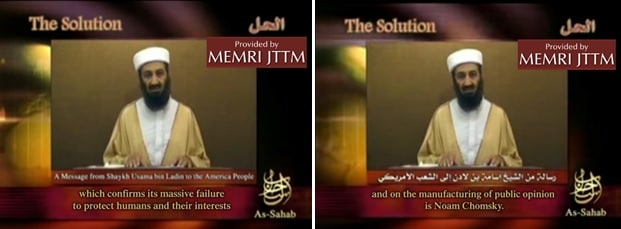
In another Al-Sahab video, "Statement to the American People," released September 13, 2009, bin Laden recommends three books that he says will "give you the truth": The Israel Lobby and U.S. Foreign Policy by Steven Walt and John Mearsheimer; Palestine: Peace Not Apartheid by U.S. president Jimmy Carter; and Apology of a Mercenary by a former CIA agent. The latter appears to be a misstated reference to Confessions of an Economic Hitman by John Perkins, to which Adam Gadahn referred in his April 2009 video. In this video, bin Laden praises Carter, saying: "The issue will become even clearer if you read what your former President Carter wrote about the racism practiced by the Israelis against our people in Palestine, or if you listened to his statement a few weeks ago, when he was visiting the destroyed and besieged Gaza, in which he said: 'The people of Gaza are treated more like animals than humans.'"

An Al-Sahab audio recording released January 29, 2010 by Al-Jazeera features bin Laden blaming the U.S. and industrialized nations for global warming. Bin Laden quoted one of Gadahn's favorite authors, saying: "Noam Chomsky was correct when he compared the U.S. policies to those of the Mafia. They are the true terrorists and therefore we should refrain from dealing in the U.S. dollar and should try to get rid of this currency as early as possible."
On September 12, 2011, Al-Sahab released a one-hour audio message by bin Laden's successor, Ayman Al-Zawahiri, followed by a previously unreleased five-minute video message from bin Laden addressed to the American people. In that message, bin Laden said that in order to end the wars in which America is involved, the American people must realize the enormous influence that the Israeli lobby and the large corporations have over America's foreign policy, and must stop supporting these bodies. This video appears to be the same as one found during the May 2011 raid on his compound in Abbottabad; both show him in a white cap against a blue backdrop.
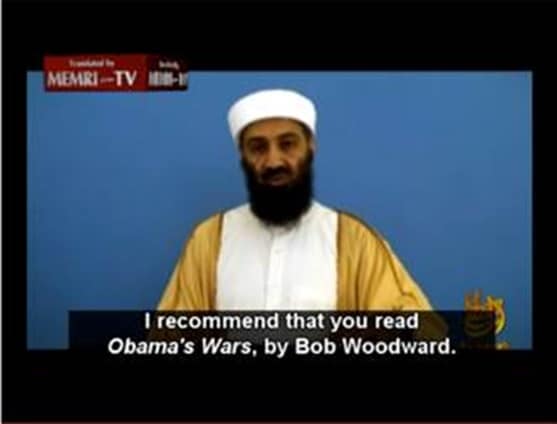
He also said in the video: "Many of your representatives in the White House and the two Houses of Congress are double agents. Even though theoretically, they are the decision makers, the real decision makers, with regard to your most important demands, are the major corporation [sic] I recommend that you read Obama's Wars, by Bob Woodward. Obama should have been more honest with you, and should have told you that pressure was being exerted on him to continue the war, as well as to support Israel, not because this was dictated by America's interests, but because it was dictated by the interests of the influential lobbies in Washington."
On the eve of the fifth anniversary of the 9/11 attacks, on September 10, 2006, Al-Qaeda released a video online that showed what appeared to be bin Laden and other Al-Qaeda commanders planning the attack. The video, with the Al-Sahab logo, was subtitled in English, and included excerpts of Bob Woodward speaking about the war in Iraq as well as voiceover by Adam Gadahn.
Al-Qaeda Leader Ayman Al-Zawahiri - Influenced By Adam Gadahn

Ayman Al-Zawahiri, the bin Laden deputy who succeeded him as Al-Qaeda leader, essentially functions as Al-Qaeda's most important ideological leader and as perhaps the main operational leader of the organization. Al-Zawahiri's father was a prominent Cairo physician, just as Adam Gadahn's grandfather was a respected doctor.[18] Over the years, there has been much speculation that Al-Zawahiri and Gadahn were close.
In a video released September 2, 2006, "An Invitation to Islam," Al-Zawahiri called Gadahn "our brother Azzam the American." He stated in the video: "Among those who have responded to this noble, divine call is our brother Azzam the American whom we ask Allah to count among those in whom is realized the statement of the Truth, Exalted is He. And as our brother Azzam the American talks to you, he talks to you as one concerned about the fate which awaits his people, and a perceptive person who wants to lead his people out of darkness and into the light. So listen to him, because what he is talking to you about is serious and significant. He is talking to you about the fate which awaits every human, an extremely grave issue in which there is no joking, procrastination or backtracking. I ask Allah to open your hearts to benefiting from his words and experience."
It is believed that Gadahn also inspired other Al-Zawahiri videos. For example, a November 19, 2008 Al-Sahab video titled "Exit of Bush and Arrival of Obama" accuses President Obama of betraying his race and his father's Muslim heritage.
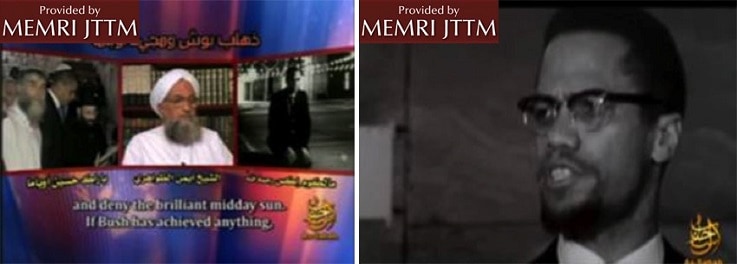
Reuters reported that Al-Zawahiri's message in that video was an "attempt to shift Al-Qaeda's focus from U.S. President George W. Bush and maintain an enmity against the United States among its supporters."[19] Zawahiri addressed Obama, saying, "You were born to a Muslim father, but you chose to stand in the ranks of the enemies of the Muslims."
Also according to Reuters, a Malcom X reference in this video likely reflects the influence of Gadahn, who in 2007 used the term "house Negro" against then-secretary of state Condoleezza Rice and also against her predecessor Colin Powell.[20] Zawahiri said: "And in you and in Colin Powell, Rice and your likes, the words of Malcolm X... concerning 'House Negroes' are confirmed." According to The New York Times, "the high quality of the English subtitles and the references to Malcom X in the tape may reflect the influence of Adam Gadahn."[21]
April 2009 Al-Sahab Video: "How To Prevent A Repeat Of The Gaza Holocaust"
In a 90-minute Al-Sahab video production titled "How to Prevent a Repeat of the Gaza Holocaust," released April 13, 2009 on Islamist websites, Gadahn reiterated accusations of atrocities committed by the West, especially the U.S., around the world. The video also included clips of bin Laden asking Arab businessmen for funding, as well as of suicide attacks in Afghanistan. Against a backdrop of footage from World War II, the Vietnam War, and more recent wars, Gadahn accused the U.S. of using chemical weapons against its enemies, of conducting mass killing of civilians, and of being driven by hatred for Islam and a desire to take control of Middle Eastern oil.
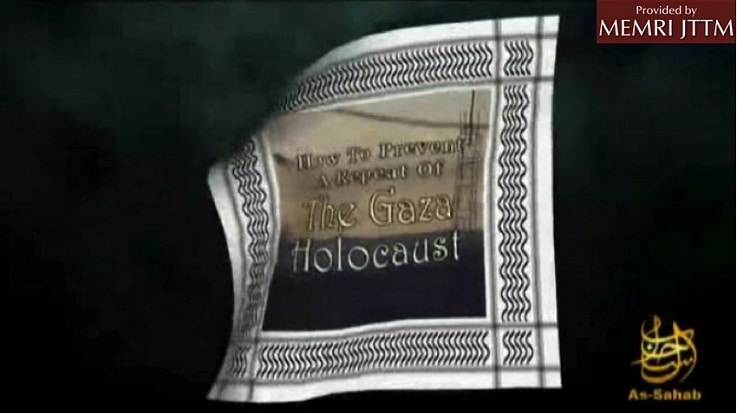
Gadahn went on to cite from John Perkins' Confessions of an Economic Hit Man and The Secret History of the American Empire; after enumerating the West's "crimes," Gadahn presents the 2008-9 Israel-Gaza war (Operation Cast Lead) as another example of "the satanic alliance [between Arab governments] and the unbelieving West." He advises Muslims that if they wish "to escape the labyrinth in which [they] are living," they must pursue "jihad in the path of Allah and the application of Allah's law," and must not be tempted by foreign concepts such as democracy and political participation.
The last part of the video shows footage of mujahideen attacks on Western and Arab forces in various Muslim lands, aimed at showing the success of the mujahideen and to drive home Gadahn's message that jihad is the only solution.
In this video, Gadahn discussed events in the U.S. in the previous month - Bernard Madoff's conviction for running a $50 billion dollar Ponzi scheme and the withdrawal of National Intelligence Council chairmanship nominee Charles Freeman, which he alleged was under pressure from the "Zionist lobby." He mentioned a U.S. Army handbook, Route Clearance, which he said had been seized in an attack on U.S. forces; a link to download the handbook had been distributed to media along with the video's release. Gadahn also talked about Americans killing Germans in World War II and the bombing of Hiroshima and Vietnam. He stated that Agent Orange, the defoliant used by the U.S. military during the Vietnam War, "contains dioxin, one of the most poisonous substances on earth," and adds that "just three ounces of it in the water supplies of New York is enough to poison its entire population." He focused also on author John Perkins and some of his books.
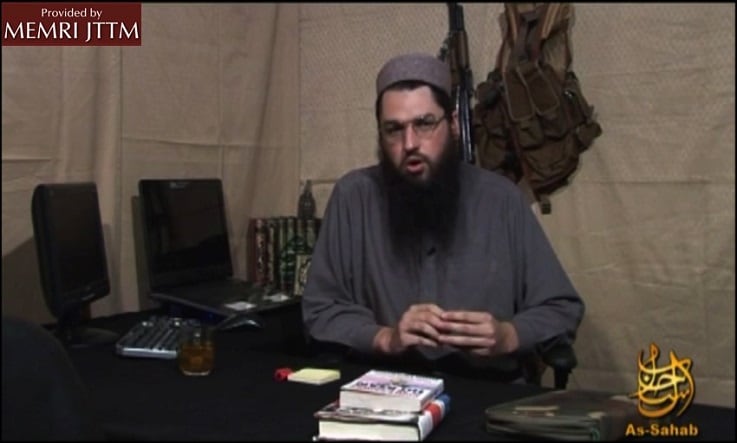
Adam
Gadahn with a copy of Perkins' The Secret History of the American Empire
He said: "First, [Charles] Freeman's assertion that Israel's interests do not coincide with the interests of the American people was enough to open him to the wrath of the Zionist lobby and expose him to the effects of that wrath. If this was how words were received, one could only imagine the effects concrete actions could have. Second, his admission that the mujahideen raid on New York and Washington were a result of America's support of Israel also angered the Zionist lobby and other elements which want to pull the wool over the eyes of the American people when it comes to the real reasons for the threats they face. And third, the Freeman case shows how opposition to America's relations with the Zionist state and its negative effects on the American people has begun to seep in to the highest levels of the American political pyramid.
"The 'corporatocracy' is the descriptive term John Perkins uses to refer to America's governmental and nongovernmental organizations and its mega corporations and financial institutions which dictate America's foreign and domestic policy, and are run by people like Bernard Madoff, the super-corrupt Jewish director of Dow Jones, to whose criminal activities successive American administrations, both Republican and Democrat, turned a blind eye for reasons yet to be explained, and who was only exposed for the financial crisis which he and others like him still at large played leading roles reached shocking proportions, and a scapegoat had to be found.
"John Perkins is an American author and activist who played a role in spreading American political, cultural and economic dominance during the years he spent as what he calls 'an economic hit man.' Perkins eventually resigned from this line of work out of disgust at the evil he and his colleagues had sown. He was actually paid hush money for years to keep him from revealing the dirty secrets to which he was privy, and for years he kept quiet until the day he saw for himself at close range the destruction wrought by the mujahideen's raids on New York and Washington [on 9/11], and appreciated that this destruction was the inevitable consequence of the American imperialism and oppression he himself had helped to engineer during his career as an EHM, at which point he resolved to write his two books, Confessions of an Economic Hitman, and The Secret History of the American Empire, in hope that his writings would lead to a popular revolt against American policy towards the world in general and the Islamic World, Africa, Asia, South America, and the rest of the so-called Third World in particular. Despite the fact that some of Perkins' opinions are at the very least dubious, such as his implied assertion that Americans should resist the American empire using peaceful methods alone, his revelations remain a wake-up call for anyone still under the mistaken impression that the corporatocracy really does want to help the world's poor and oppressed and do what is in the best interest of under-developed nations.

Adam Gadahn holding Perkins' Confessions
of an Economic Hitman
"'The Saudi Arabian money laundering affair,' as Perkins and his colleagues called this deal, was designed to Americanize the Arabian Peninsula in general and the country of the two centuries in particular - culturally, economically, and militarily - by making its continued economic prosperity and development contingent on continued cooperation with America and its Western crusader allies. In other words, as Perkins makes clear, an elite corps of foreigners hostile to Islam and Muslims would determine the future appearance and economic make-up of the Arabian Peninsula. The Muslims' oil resources would be plundered, the corporatocracy's coffers would be filled to the brim with ill-gotten wealth, and America's and Israel's security would be assured, all in exchange for their propping up of the apostate rulers in Riyadh who capitulated to America's usurious conditions without the slightest hesitation."
December 2009 Al-Sahab Video Uses Sean Penn Film, Other Western Books Praised By Gadahn
Another 2009 Al-Sahab video, released in December of that year, was narrated by Gadahn and focused on alleged U.S. military atrocities. Gadahn cites Western sources critical of U.S. military intervention in scenes from the 2007 film War Made Easy: How Presidents and Pundits Keep Spinning Us to Death, which is narrated by Sean Penn and based on a book of the same name by Norman Solomon. The video also refers, several times, to Perkins' The Secret History of the American Empire.

Gadahn states: "Praise Allah and give thanks to him for the enemy. And the result of its unabated bleeding has begun to show on his economy, which is on the brink of failure. This is first and foremost through the grace of Allah and then the huge sacrifices of your sons, the mujahideen who are eager for you, to stand by your side and to reinforce them with money and men; for after Allah, they are your only hope for deliverance from decades of humiliation and weakness."
The Abbottabad Documents: Showing "The Quiet Ascent of Adam Gadahn"
Knowledge of Gadahn's influence within Al-Qaeda was cemented with the May 2, 2011 raid on the Abbottabad compound in Pakistan, in which bin Laden was killed and computers, hard drives, videos, thousands of pages of documents, and more were seized by U.S. Special Forces. The majority of the documents and information taken that night remain classified.
In March 2012, prior to the declassification of some of the materials, Washington Post writer David Ignatius wrote a series of articles on some of the documents found in the raid. Ignatius revealed a plan in one document to assassinate President Obama and conduct terrorist operations marking the 10th anniversary of 9/11. One letter from Gadahn to bin Laden discussed which U.S. television outlets would be the best to air a bin Laden anniversary video - noting that all were good except for Fox News. In another letter, 21 pages long, Gadahn advised bin Laden on media tactics for the upcoming months, including the timing of video releases - according to Ignatius, "much as if he were a media planner corresponding with a client."[22] Also in this letter, Gadahn expressed his concerns about operations conducted by Al-Qaeda affiliates that were harming innocent Muslims who were bystanders in attacks.
In May 2012, following Ignatius' articles, 17 letters, including some he had discussed, were declassified. These letters were translated, analyzed, and released by the Combating Terrorism Center (CTC) at West Point. One of the first to analyze the Abbottabad letters was Brian Dodwell, Director of Practitioner Education at the CTC. Identifying Gadahn as the "breakout personality" from the documents, he wrote in an article: "Gadahn's letter received considerable publicity both before and after the release of the Abbottabad documents. Much of this attention, however, focused on the more salacious material Gadahn provided regarding his opinions of various Western media outlets and personalities. Not only does this information provide limited value, but it is not sufficiently indicative of Gadahn's role as media advisor to Western media within Al-Qaeda. Much more interesting is what he exposed about his own beliefs, his understanding of the jihadist ideology, and his role beyond that of a media adviser within the organization. This article provides an assessment of Gadahn's position and impact in Al-Qaeda and includes a discussion of his trajectory as a propagandist and his emergence as a substantive contributor to debates with senior leadership over key ideological and strategic issues."[23]
*Steven Stalinsky is executive director of The Middle East Media Research Institute (MEMRI), and author of the forthcoming book American Traitor: The Rise and Fall of Al-Qaeda's U.S.-Born Leader Adam Gadahn.
Endnotes:
[1] Dni.gov/index.php/resources/bin-laden-bookshelf
[2] MEMRI JTTM report Al-Qaeda's 'Resurgence' Magazine Features Posthumously Released In-Depth Interview With Al-Qaeda Media Operative Adam Gadahn, June 25, 2015.
[3] The Orange County Register, September 24, 2006; May 26, 2010.
[4] Inside Edition, July 7, 2006; July 20, 2010.
[5] The New Yorker, January 22, 2007; June 28, 2010.
[6] The New Yorker, January 22, 2007; June 28, 2010.
[7] FOX News, May 27, 2004; June 1, 2010.
[8] Los Angeles Times, October 8, 2006.
[9] Globatljihad.net, September 28, 2008.
[10] ABC, July 11, 2007.
[11] ABC, June 2, 2008. Previously, MSNBC reported that Gadahn's videos offered clues about Al-Qaeda's propaganda machine and about what kind of recruits the organization was seeking, i.e. native-born Americans and Europeans. MSNBC, July 14, 2006.
[12] Fox News, June 23, 2006.
[13] Fox News, June 23, 2006.
[14] Los Angeles Times, October 8, 2006.
[15] The Examiner, March 8, 2010.
[16] The Guardian, October 29, 2004.
[17] The Washington Post, January 21, 2006.
[18] CNN, June 11, 2006.
[19] Reuters, November 19, 2015.
[20] Reuters, November 19, 2015.
[21] The New York Times, November 19, 2008.
[22] The Washington Post, March 20, 2012.
[23] Dodwell, Brian. "The Abbottabad Documents: The Quiet Ascent of Adam Gadahn," The Combating Terrorism Center, West Point, May 22, 2012.




